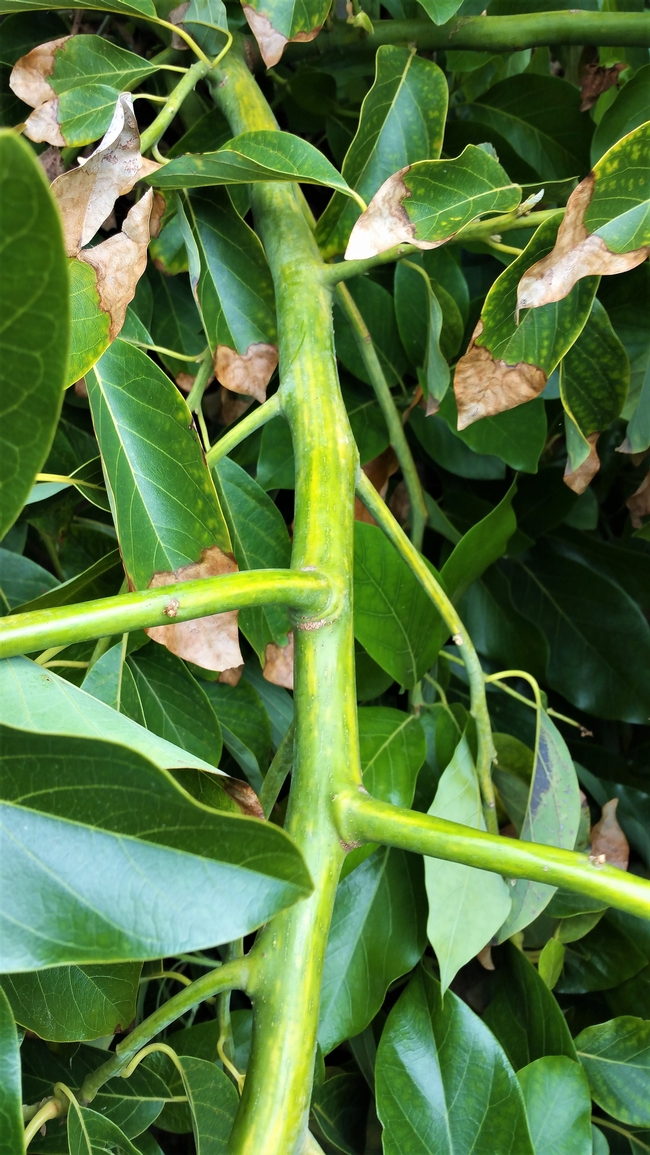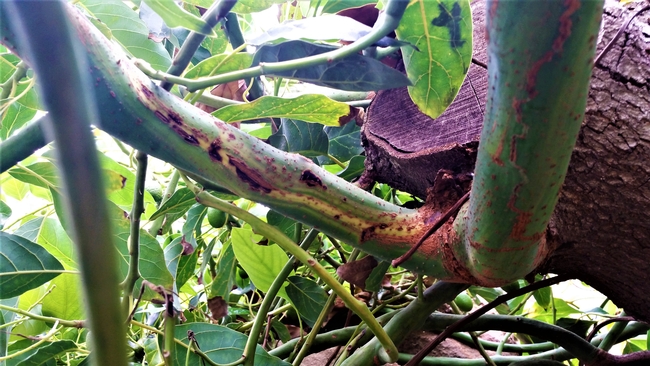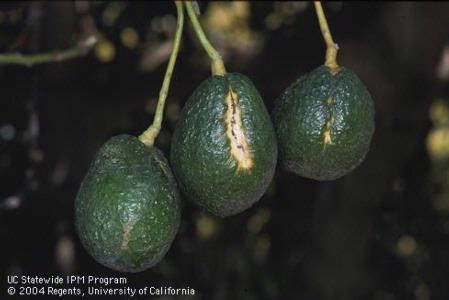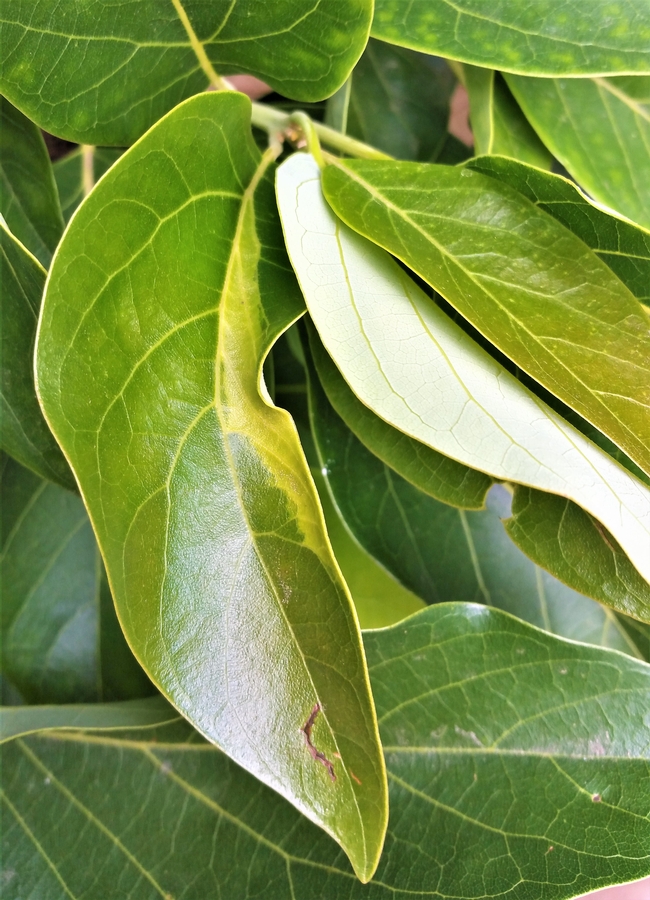
Posts Tagged: sun blotch
Let’s talk about Avocado Sunblotch Viroid
Photo: Sun Blotch Branch
Sun-blotch, a viroid disease affecting the avocado, was observed as early as 1914 in Southern California. Sun-blotch is widespread in California, and likely to be found in all districts where avocados are being grown. The main counties in which the disease is found are San Diego, Ventura, Los Angeles, Orange, Riverside, and Santa Barbara.
Symptom's and signs
Sunblotch causes a wide variety of symptoms or may exhibit no symptoms in some hosts. The rate of spread of sunblotch virus appears to be extremely slow due to improved cultural practices in the nursery and field, and the apparent absence of an insect vector. Symptoms of sunblotch include necrotic, red, yellow, or white discolorations on fruit, often in depressions or scars in the fruit surface. Twigs can develop narrow, necrotic, red or yellow streaks on their surface or in shallow lengthwise indentations along the twig. Leaves may have white or yellowish variegated areas and be deformed, but leaf symptoms are uncommon. Rectangular cracking and checking of the bark, called "alligator bark," often occurs on the trunk and larger branches. Infected trees may be stunted and have a disproportionate amount of horizontal growth or sprawling lateral low limbs. Trees with visible sunblotch symptoms often have reduced yields. Infected trees can also be symptomless, although large reductions in yield of previously vigorous trees may indicate the presence of the viroid in otherwise symptomless carriers.
Photo: Sunblotch fruit
Sunblotch is caused by dozens of variants of submicroscopic particles of genetic material (viroids, smaller than a virus with no protein coat and only nucleic acid) that alter development and growth of infected plants. Sunblotch viroid can move systemically within avocado, and it persists in host tissues. Trees that do not show symptoms even though the viroid is present are known as "symptomless carriers." Nearly all cuttings and seed from symptomless carriers will be infected with viroid. However, seedlings from symptomless carriers do not show symptoms of sunblotch when they are used as rootstocks, but the disease often appears on scions grafted to them. Conversely, most seed from trees with symptoms are not infected, and budwood and shoot cuttings from sunblotch leaf symptomatic trees often do not contain viroid. [BF1] The viroid is transmitted in pollen, but pollen only infects the fruit and seed produced from it. Unless a tree is infected by grafting or some way other than through pollen, there will be no viroid in budwood, root grafts, and shoot cuttings from that tree. [BF2] Transmission of the viroid most often occurs during grafting by using infected budwood or rootstock seedlings from infected trees with or without symptoms. Natural root-to-root grafts are important in transmitting sunblotch in groves. Mechanical transmission through wounds caused by contaminated harvest clippers, pruning tools, and injection equipment can also be important if infected trees are in the grove. [BF3] Spread via pollen from an infected tree to the flower ovule of a noninfected avocado, resulting in infected seed, can cause fruit to be culled, but does not further spread the disease unless seed is propagated. There is no evidence of insect transmission.
Management
Nursery
Careful propagation of nursery stock to eliminate viroid has greatly reduced sunblotch to a relatively minor disease. However, ongoing monitoring and management is required in nurseries and established groves. Sunblotch can be easily overlooked, and there are many ways that trees can become infected. Look for diseases and disease-promoting conditions regularly throughout the grove. In the nursery, carefully select disease-free scions and seed sources. Use stringent sanitation and frequent disinfection to avoid spreading pathogens. Periodically confirm that propagation sources are disease-free (indexing) by grafting propagative source material to young Mexican seedlings and observing leaves and twigs for sunblotch symptoms, or by performing a genetic test. Plant only indexed nursery stock that is registered as disease-free.
Field
Promptly remove symptomatic trees from the grove and chemically kill the stumps. Do not retain infected, symptomless trees just because yield does not seem to be affected; symptomless carriers are a highly infective source that can dramatically reduce yield on other trees. If only fruit and seed are infected (from infected pollen), it may not be necessary to remove that tree if indexing indicates the rest of the tree is not infected. However, trees with only fruit and seed infection indicate that other infected (possibly symptomless) trees nearby need to be indexed or removed. The danger of spreading viroid increases in established orchards where mature trees are pruned to reduce tree size and restimulate or maintain fruit production. Severe pruning of symptomless carriers, and perhaps other severe causes of tree stress, are suspected of causing viroid to become active in the new growth, inducing previously symptomless trees to exhibit symptoms. Disinfect pruning tools, harvest clippers, and injection equipment before beginning work on a new tree. Scrubbing tools clean and then soaking them in a 1.5% sodium hypochlorite solution is effective. Growers must use a registered disinfectant and follow label directions.
Photo: Sunblotch leaf
As sunblotch is systematic in the avocado tree, it can exist in the roots as well as the above-ground parts. Thus, it might be transmitted through natural root graftage between a healthy and diseased tree. It is known that tree roots will sometimes become forced together in some manner until finally a natural root graft has taken place. The natural grafting between roots of trees has been attributed to a number of causes, some of which are as follows: (1) Roots growing in a shallow soil underlaid by a hardpan when crowded for growing space will sometimes become grafted together. (2) Two roots growing between two rocks or other barriers when wedged together tightly may form a graft. (3) Roots from mature avocado trees which are planted close together in a grove may, if crowded for growing space, form a graft. It is believed, through evidence existing in certain avocado orchards, that sun-blotch disease has infected healthy trees through natural root graftage.
Photo: Sun Blotch branch with salt-affected leaves 
Avocado Sunblotch Viroid testing by RT-Qpcr Grove Sampling Project
Avocado sunblotch viroid (ASBVd) is a small (247 nt) pathogen that causes discoloration and disfigurement of leaves and fruit. It is transmitted by grafting, pruning tools, pollen, seed, and root grafting. Trees may recover from the symptomatic expression of the viroid and become “symptomless carrier” trees. These trees maintain high levels of the viroid in leaves, fruit and seed, but do not express the characteristic sunblotch symptoms shown above. The viroid is also readily transmitted by the pollen of these trees. One characteristic of these trees is they typically have low fruit set. If such trees were used for the production of nurse seeds, widespread transmission of the viroid could occur.
Our laboratory has developed a real time quantitate RT-qPCR protocol for quickly and sensitively detecting ASBVd in both mature field trees and small greenhouse/nursery trees.
Details of sunblotch testing
Collection of tissue for ASBVd testing is as follows: All leaves should be hardened off and mature, but not excessively old or damaged by insects or wind. Ideally, each leaf should come from a separate branch to ensure a representative sample from around the canopy of the tree. Place leaves in plastic zip lock bags with NO WET TOWELS or other material.
For mature field trees the method is: Harvest 10 leaves from each of the 4 compass points. Place the 10 North and 10 East leaves in one bag, the 10 South and 10 West leaves in another bag, so you will have “sample 1-NE, and 1-SW”, etc., 2 bags for each tree. If you see symptomatic fruit, include the fruit and 2-3 leaves from directly behind that fruit in a separate bag.
For small nursery trees or newly planted field trees (2-4 ft tall, 1-4 branches): if there are only 1-2 shoots, 2-3 leaves from each plant can be collected (at least one leaf from each shoot); for slightly bigger trees, collect 6-8 leaves from each tree (2 leaves from each branch). It is very important to collect the most mature and fully expanded leaves from the small trees. Avoid the young expanding feathery leaves.
If any pruning or cutting tools are used in sample collecting they need to be disinfected for 2-5 minutes between trees with a freshly made (within 2 hours) 20% dilution of 5% household bleach (generally speaking: 2 parts bleach to 8 parts water), then rinsed with water before cutting the next tree.
The total number of leaves collected as above should be 20 or less per bag. Samples should be sent by overnight shipping and in the summer should be placed in styrofoam containers with reusable ice packs. Results are usually available within 10-14 days after receipt, depending on demand.
Contact Georgios Vidalakis (vidalg@ucr.edu, lab: 951-827-4932, office: 951-827-3763, cell: 951-237-9948) for more information and scheduling.
Typical symptoms of ASBVd on fruit and leaves (lower left branch)

sunblotch

sunblotch leaves



